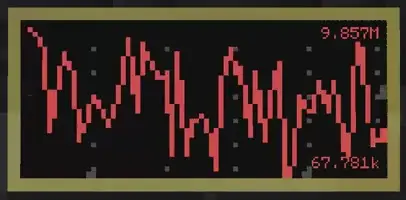Line Chart Output beta Source
telem.output.plotter.line (
win: window,
filter: string,
bg: color,
fg: color,
maxEntries: number
)TIP
This adapter is cacheable.
Search the available metrics using the syntax defined in find and output a line chart to a specified window. If a matching metric is found, the metric value is pushed to the chart buffer.
The X axis (horizontal value) represents the number of data points recorded, and has a default width of 50, which can be overridden by passing maxEntries in the constructor. The Y axis (vertical) represents the value of the metric over time. Once the fixed width of the graph is reached, the oldest values will be dropped from the buffer when new values are added. The minimum and maximum range of the Y axis is determined by the minimum and maximum metric values in the graph buffer. The background of the widget and all labels will be bg, and the graph/text color will be fg.
The minimum and maximum labels are designed to shorten themselves using SI suffixes to fit within the available width.
| Name | Type | Default |
|---|---|---|
win | window instance | nil |
Window to draw in. Any window-compatible object should work; however, you will need to wrap | ||
filter | string | nil |
| Filter to match against Metric elements | ||
bg | color | nil |
Background color, one of | ||
fg | color | nil |
Foreground color, one of | ||
maxEntries | number | 50 |
| Maximum entries in the chart buffer | ||
Usage
local telem = require 'telem'
local mon = peripheral.wrap('top')
mon.setTextScale(0.5)
local monw, monh = mon.getSize()
local win = window.create(mon, 1, 1, monw, monh)
local backplane = telem.backplane()
:addInput('custom_rand', telem.input.custom(function ()
return {
rand = math.random() * 10000000
}
end))
:addOutput('monitor_rand1', telem.output.plotter.line(win, 'rand', colors.black, colors.red))
parallel.waitForAny(
backplane:cycleEvery(0.1)
)Behavior
2x1 Advanced Monitor (0.5x scale)

3x2 Advanced Monitor (0.5x scale)
